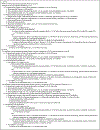Gestational age and birth growth parameters as early predictors of fetal alcohol spectrum disorders
- PMID: 34342019
- PMCID: PMC8429067
- DOI: 10.1111/acer.14656
Gestational age and birth growth parameters as early predictors of fetal alcohol spectrum disorders
Abstract
Objective: To investigate gestational age and growth at birth as predictors of fetal alcohol spectrum disorders (FASD).
Methods: The sample analyzed here comprises 737 randomly selected children who were assessed for growth, dysmorphology, and neurobehavior at 7 years of age. Maternal interviews were conducted to ascertain prenatal alcohol exposure and other maternal risk factors. Birth data originated from clinic records and the data at 7 years of age originated from population-based, in-school studies. Binary linear regression assessed the relationship between preterm birth, small for gestational age (SGA), and their combination on the odds of a specific FASD diagnosis or any FASD.
Results: Among children diagnosed with FASD at 7 years of age (n = 255), a review of birth records indicated that 18.4% were born preterm, 51.4% were SGA, and 5.9% were both preterm and SGA. When compared to non-FASD controls (n = 482), the birth percentages born preterm, SGA, and both preterm and SGA were respectively 12.0%, 27.7%, and 0.5%. Mothers of children with FASD reported more drinking during all trimesters, higher gravidity, lower educational attainment, and older age at pregnancy. After controlling for usual drinks per drinking day in the first trimester, number of trimesters of drinking, maternal education, tobacco use, and maternal age, the odds ratio of an FASD diagnosis by age 7 was significantly associated with SGA (OR = 2.16, 95% CI: 1.35 to 3.45). SGA was also significantly associated with each of the 3 most common specific diagnoses within the FASD continuum: fetal alcohol syndrome (FAS; OR = 3.1), partial FAS (OR = 2.1), and alcohol-related neurodevelopmental disorder (OR = 2.0).
Conclusion: SGA is a robust early indicator for FASD in this random sample of children assessed at 7 years of age.
Keywords: Preterm; fetal alcohol spectrum disorders; prenatal alcohol exposure; small for gestational age.
© 2021 by the Research Society on Alcoholism.
Conflict of interest statement
Figures



Similar articles
-
Maternal risk factors for fetal alcohol syndrome and partial fetal alcohol syndrome in South Africa: a third study.Alcohol Clin Exp Res. 2008 May;32(5):738-53. doi: 10.1111/j.1530-0277.2008.00634.x. Epub 2008 Mar 11. Alcohol Clin Exp Res. 2008. PMID: 18336634
-
The prevalence of fetal alcohol spectrum disorders in rural communities in South Africa: A third regional sample of child characteristics and maternal risk factors.Alcohol Clin Exp Res. 2022 Oct;46(10):1819-1836. doi: 10.1111/acer.14922. Epub 2022 Sep 1. Alcohol Clin Exp Res. 2022. PMID: 35971629 Free PMC article.
-
The prevalence, child characteristics, and maternal risk factors for the continuum of fetal alcohol spectrum disorders: A sixth population-based study in the same South African community.Drug Alcohol Depend. 2021 Jan 1;218:108408. doi: 10.1016/j.drugalcdep.2020.108408. Epub 2020 Nov 13. Drug Alcohol Depend. 2021. PMID: 33250379 Free PMC article.
-
Risk of stillbirth, preterm delivery, and fetal growth restriction following exposure in a previous birth: systematic review and meta-analysis.BJOG. 2018 Jan;125(2):183-192. doi: 10.1111/1471-0528.14906. Epub 2017 Oct 3. BJOG. 2018. PMID: 28856792
-
Systematic literature review on which maternal alcohol behaviours are related to fetal alcohol spectrum disorders (FASD).BMJ Open. 2018 Dec 19;8(12):e022578. doi: 10.1136/bmjopen-2018-022578. BMJ Open. 2018. PMID: 30573481 Free PMC article.
Cited by
-
The influence of maternal weight and alcohol exposure on infant physical characteristics and neurodevelopmental outcomes.Curr Res Toxicol. 2022 May 20;3:100076. doi: 10.1016/j.crtox.2022.100076. eCollection 2022. Curr Res Toxicol. 2022. PMID: 35694418 Free PMC article.
-
Maternal and paternal risk factors associated with diagnoses within the continuum of fetal alcohol spectrum disorders in the USA: Proximal and distal influences.Alcohol Clin Exp Res (Hoboken). 2025 Jan;49(1):185-204. doi: 10.1111/acer.15501. Epub 2024 Dec 12. Alcohol Clin Exp Res (Hoboken). 2025. PMID: 39667847
-
The Impact of Prenatal Alcohol Exposure on Longitudinal Growth, Nutritional Status, and Insulin-Like Growth Factor 1 in Early Childhood in Leyte, the Philippines.J Pediatr. 2024 Jun;269:113977. doi: 10.1016/j.jpeds.2024.113977. Epub 2024 Feb 23. J Pediatr. 2024. PMID: 38401788 Free PMC article.
-
Alcohol Exposure May Increase Prenatal Choline Needs Through Redirection of Choline into Lipid Synthesis Rather than Methyl Donation.Metabolites. 2025 Apr 24;15(5):289. doi: 10.3390/metabo15050289. Metabolites. 2025. PMID: 40422867 Free PMC article.
-
Prenatal alcohol exposure and associations with physical size, dysmorphology and neurodevelopment: a systematic review and meta-analysis.BMC Med. 2024 Oct 15;22(1):467. doi: 10.1186/s12916-024-03656-w. BMC Med. 2024. PMID: 39407296 Free PMC article.
References
-
- Abel EL (1998) Fetal Alcohol Abuse Syndrome. New York, NY, Springer US.
-
- Arcangeli T, Thilaganathan B, Hooper R, Khan KS, Bhide A (2012) Neurodevelopmental delay in small babies at term: A systematic review. Ultrasound Obstet Gynecol 40:267–275. - PubMed
-
- Bada HS, Das A, Bauer CR, Shankaran S, Lester BM, Gard CC, Wright LL, LaGasse L, Higgins R (2005) Low birth weight and preterm births: Etiologic fraction attributable to prenatal drug exposure. J Perinatol 25:631–637. - PubMed
-
- Bailey BA, Sokol RJ (2008) Is prematurity a part of fetal alcohol spectrum disorder? Expert Rev Obstet Gynecol 3:245–255.
Publication types
MeSH terms
Grants and funding
LinkOut - more resources
Full Text Sources
Medical
Research Materials
Miscellaneous

